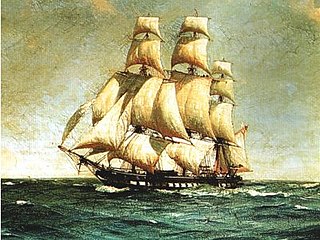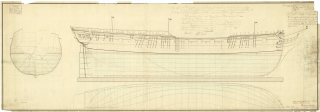Career
Commander Charles Smyth commissioned her in October 1793. He then sailed for Nova Scotia in May 1794. Alert was off the coast of Ireland when she had the misfortune to encounter the 40-gun French frigate Unité.
At daybreak on 14 May Alert was at 46°35′N15°15′W / 46.583°N 15.250°W / 46.583; -15.250 when she sighted three vessels. These edged towards Alert, as she edged away, and the strangers did not respond to Alert's signals. At about 10:45 another three vessels appeared. The strange vessels signaled to each other, and most sailed away, but one remained in chase. Then at noon some vessels appeared off Alert's bow and Smyth decided to engage his pursuer to try to cripple her and so escape. Alert and the frigate closed at about 1:45pm and an action commenced after Smyth declined an invitation to strike. By 3:30 Alert had lost three men killed and nine wounded, her rigging and sails were shredded, and she had taken shots between wind and water. At this point Smyth struck.
The French took her into service as Alerte. Some four months later, on 23 August, HMS Flora, Captain John Borlase Warren, and HMS Arethusa, Captain Sir Edward Pellew, chased two French corvettes, Alerte and Espion into Audierne Bay. The two corvettes anchored off the Gamelle Rocks, but when they saw that the British intended to capture them, their captains got under weigh and ran their vessels aground below the guns of three shore batteries. The corvettes continued to exchange fire with the two British frigates until early evening, when the corvettes' masts fell. At that point many of the French crewmen abandoned their vessels and went ashore. Warren sent in the boats from both Flora and Arethusa, all under Pellew's command, with orders to set fire or otherwise destroy the two corvettes. Pellew went in and took possession of both, but determined that he could not extract the wounded. Pellew therefore left the vessels, which he determined were bilged and scuttled, with rocks having pierced their bottoms, and left with 52 prisoners. Pellew estimated that Alerte had suffered 20 to 30 men killed and wounded, and that Espion had lost more. [4]
French records indicate that Alerte, which had been under the command of lieutenant de vaisseau Passart, had been scuttled and was lost. However, the French Navy was able to refloat Espion, which had been under the command of lieutenant de vaisseau Magendie. [5] [lower-alpha 1]

HMS Hannibal was a 74-gun third-rate ship of the line of the Royal Navy, launched on 15 April 1786, named after the Carthaginian general Hannibal. She is best known for having taken part in the Algeciras Campaign, and for having run aground during the First Battle of Algeciras on 5 July 1801, which resulted in her capture. She then served in the French Navy until she was broken up in 1824.

HMS Arethusa was a 38-gun Minerva-class fifth-rate frigate of the Royal Navy built at Bristol in 1781. She served in three wars and made a number of notable captures before she was broken up in 1815.

HMS Babet was a 20-gun sixth-rate post ship of the British Royal Navy. She had previously been a corvette of the French Navy under the name Babet, until her capture in 1794, during the French Revolutionary Wars. She served with the British, capturing several privateers and other vessels, and was at the Battle of Groix. She disappeared in the Caribbean in 1800, presumably having foundered.
HMS Lively was a 32-gun fifth-rate Alcmene-class frigate of the British Royal Navy launched on 23 October 1794 at Northam, Devon. She took part in three actions one a single-ship action, one a major battle, and one a cutting-out boat expedition – that would in 1847 qualify her crews for the issuance of the Naval General Service Medal. Lively was wrecked in 1798.
Coquille was a 40-gun frigate of the French Navy, lead ship of her class, and launched in 1794. The Royal Navy captured her in October 1798 and took her into service as HMS Coquille, but an accidental fire destroyed her in December 1798.
Vénus was a corvette of the French Navy that the British captured in 1800. Renamed HMS Scout, she served briefly in the Channel before being wrecked in 1801, a few days after taking a major prize.
Sixteen ships of the Royal Navy have borne the name HMS Alert, while another was planned:

Cléopâtre was a 32-gun Vénus class frigate of the French Navy. She was designed by Jacques-Noël Sané, and had a coppered hull. She was launched in 1781, and the British captured her in 1793. She then served the Royal Navy as HMS Oiseau until she was broken up in 1816.

Bayonnaise was a 24-gun corvette of the French Navy, launched in 1793. She became famous for her capture of HMS Ambuscade on 14 December 1798. Her crew destroyed Bayonnaise in November 1803 to prevent her capture.

Sensible was a 32-gun Magicienne-class frigate of the French Navy. The Royal Navy captured her in 1798 off Malta and took into service as HMS Sensible. She was lost in a grounding off Ceylon in 1802.
Jean-Jacques Magendie was a French Navy officer. He famously captained the flagship Bucentaure at the Battle of Trafalgar.

L'Espoir was a French brig-sloop that served for 9½ years in the French Navy before HMS Thalia captured her in September 1797. In her subsequent short career in British service as HMS Espoir she captured three prizes, with the capture in 1798 of the more heavily armed Genoese pirate Liguria earning her crew a clasp to the Naval General Service Medal. Espoir was laid up in 1799 and sold in 1804.

Gracieuse was a 32-gun Charmante-class frigate of the French Navy. Renamed to Unité in 1793, she took part in the French Revolutionary Wars. The Royal Navy captured her in 1796 off Île d'Yeu and brought her into British service as HMS Unite. She was sold in 1802

Alceste was a Magicienne class frigate of the French Navy, launched in 1780, that the British seized at the Siege of Toulon. They transferred her to the Kingdom of Sardinia, but the French recaptured her a year later in the action of 8 June 1794. The British captured her again at the action of 18 June 1799 and took her into service as HMS Alceste. In 1801 she became a floating battery and she was sold the next year.
The French brig Alerte was launched in April 1787. The Royal Navy captured her at Toulon in August 1793, and renamed her HMS Vigilante. The British set her on fire when they evacuated Toulon in December of that year. After the French rebuilt her as Alerte, she served at the Battle of Aboukir Bay. The British recaptured her in June 1799 and took her into service as HMS Minorca. Minorca was sold in 1802.
Flèche was a French corvette built by Louis-Hilarion Chapelle (cadet) and launched at Toulon in 1768. The British captured her at the Fall of Bastia in May 1794 and commissioned her into the Royal Navy under her existing name. She observed the naval battle of Hyères Islands, but then wrecked in 1795.
HMS Ranger was the 14-gun revenue cutter Rose, launched in 1776, that the Royal Navy purchased in 1787, and that the French captured in 1794. The British recaptured her (twice) in 1797 and renamed her HMS Venturer. The Navy sold her in 1803.

Robert was a 16-gun French privateer corvette launched in 1793 at Nantes. The British captured her in 1793 and named her HMS Espion. The French recaptured her in 1794 and took her into service as Espion. The British recaptured her in 1795, but there being another Espion in service by then, the British renamed their capture HMS Spy. She served under that name until the Navy sold her in 1801. Spy then became a slave ship, a merchantman to South America, and privateer again. The French captured her in mid-1805 and sent her into Guadeloupe.
HMS Amethyst was launched in 1790 as the French frigate Perle. The British Royal Navy took possession of her at Toulon in 1793. She was wrecked in 1795 at Alderney.

HMS Artois was a fifth-rate Artois-class frigate of the Royal Navy, designed by Sir John Henslow and launched in 1794 at Rotherhithe as the lead ship of her class. She served for the majority of her career in the English Channel under the command of Edmund Nagle in the squadrons of Edward Pellew and John Borlase Warren, notably taking part in the action of 21 October 1794 where she captured the 44-gun frigate La Révolutionnaire almost singlehandedly. She participated in a number of other actions and events including the attempted invasion of France in 1795. Artois continued to serve actively on the coast of France in blockade and patrolling roles, taking a large number of ships as prizes, until she was wrecked with no loss of life off Île de Ré on 31 July 1797 while attempting to reconnoitre the harbour of La Rochelle.










